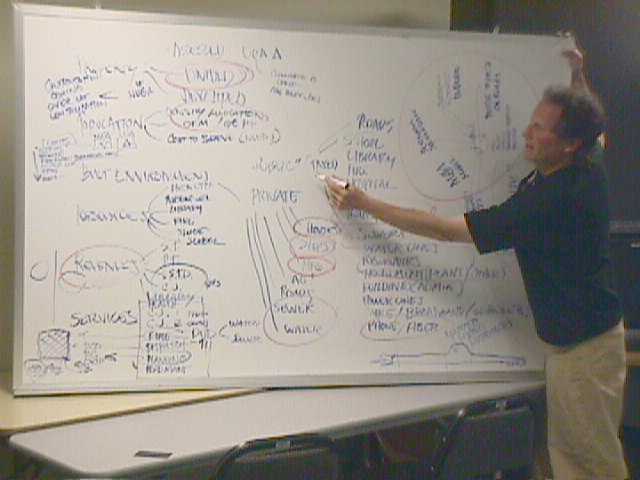
 <
<I believe that you will have to read both of these Sea Grant books, as their content overlaps in important ways.
The good news is that they are reasonably easy to find and delightful.

The USDA-FS book () R6-ECOL-TP-001-88) is harder to find. We got copies of it when it was published for each of our local libraries, but that was years ago and I have no idea if they are still around. There is no clearer introduction to the role of forest fires in our landscape and I will excerpt large blocks of that section for this site.


Jim Lichatowich's story "River of Stone" was published in Peninsula Magazine in Spring 1991. This brief article sets the stage for his 1999 book Salmon Without Rivers, and contains one of the core concepts necessary for understanding the current instream flow dilemma, set forth with such mathematical purity that I am sure that a school-child can understand it.
"An aggraded river is difficult to detect and repair because it changes so slowly that we forget what the river looked like in its pristine state. Our collective memory does not go back far enough to associate today's condition with a deteriorated change. I've had people tell me, "Well the river has always looked that way." The events that led up to the present problem may have originated back in time beyond the memory of present-day residents of the Dungeness Valley. But natural and man-made markers can help us gauge long-term changes in the river. One of those gauges is the lower river levee. The U.S. Army Corps of Engineers built the levee to contain flood waters along the lower 2.5 miles of the east bank of the river. When the levee was completed in 1964 it was capable of containing flood waters the magnitude of which we expect to see in the Dungeness only once every 200 years. Now, twenty-six years later, the levee is only capable of containing the flood waters we expect to see once in every twenty-five years. In other words, today the levee will contain a much smaller flood than in 1964. The levee hasn't worn down, the river bottom has risen-the result of gravel aggradation."
The situation Jim explains is NOT simply the result of human activities like diverting the river into irrigation ditches, diking the river bank, or building bridges that stand with their feet in the river. This is a problem that began far upstream in the glacial lakes, with the sediments and gravels at the bottom of the fjords that formed while ice was still heavy on the land. It is the millions of cubic yards of gravel that came down from Canada with the ice and were left behind, perched in valleys as much as 5000 feet above sea level.
Father upstream, in the canyon of the Graywolf you can see it clearly in the landscape. On one side of the river is the basalt bedrock - the remains of that seamount that got stuck in the subduction zone - but on the other side, where there is a trail, the ground slopes steeply into the river. What you see if you stop to look, includes layers of lake bottom clays and a river that continues to downcut along the rock wall.
Some of the these sloping sediment layers are exposed far above the river, under the duff of the forest floor. Every so often the river takes a bite out of the eastern bank, and chokes on it, sending a breif torrent that moves more gravel toward the sea. And every few hundred years, fire returns and in the wake of the fire, water finds its way onto the clay between layers and lubricates a huge landslide that falls into into the river and yet another pulse of material begins its journey to the sea.
Jim wrote:
"The heavy load of gravel in the Dungeness channel has affected all the people and animals that depend on the river. As the layer of gravel gets thicker, more and more water flows subsurface through the gravel instead of above where it can be used by people, fish and animals. As the channel widens due to bank erosion, the remaining surface water spreads out and becomes shallower. In some places, the amount of water flowing on the surface has been reduced to the point where it is too shallow for adult salmon to migrate upstream to spawn without help from man. Water withdrawals for irrigation and other uses such as municipal water supply increase the problems the salmon must deal with. Farmers can point out that they have been withdrawing water from the river for 100 years without hurting the salmon. The slow changes in the river of stone have altered the relationship between farmer and fish. The ripples have radiated out to encircle both farmer and fish in a struggle for water, a struggle neither created but neither can avoid."
Now comes the tricky stuff: This next discussion leads directly to the jaws of the current hot potato issues surrounding "Best Avaialable Science" about which I've written an essay that I will only mention here, but not reference yet.
The following unpublished 1972 manuscripts by W.A. Long USFS Geologist are w/o doubt some of the best available science - arguably some of the best science ever done in this region, and they explain more than most of the peer reviewed stuff can, cuz they are the real thing: geology done by a geiologist walking around with a sighting compass and an altimeter and a rock-hammer, following the trail of the glaciers, breaking rocks and making maps. We put a complete set of these in the Library in about 1993, but I did not see it last month when I was looking for old documents there. I still have at least 6 volumes of these complete with maps.




No comments:
Post a Comment